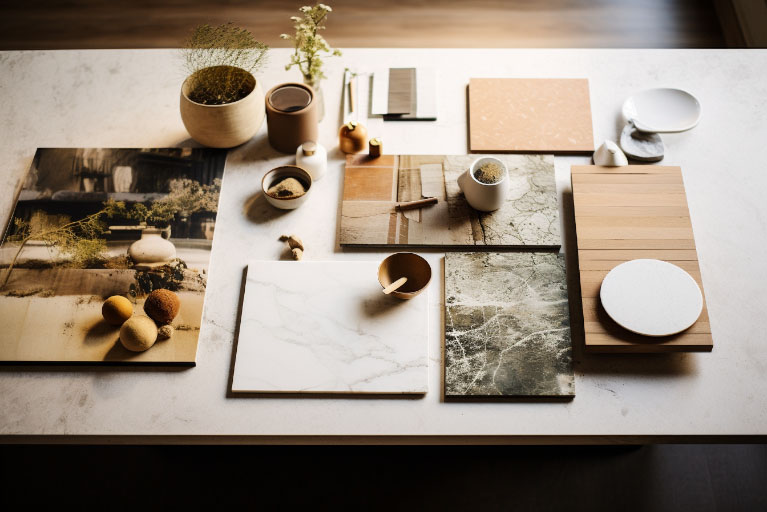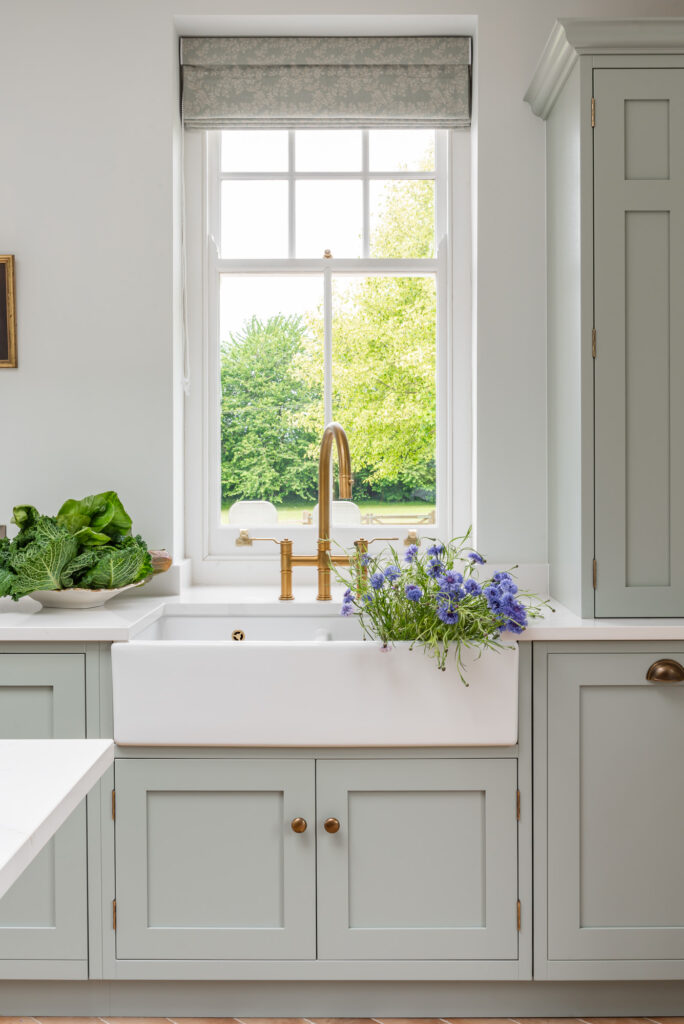The workhorse of any kitchen and worktops need to be tough and practical to use, as well as stylish. Marble, granite, ceramic, timber… Choosing a kitchen work surface can be tricky. While cabinetry will be the main style decision you make for your kitchen, never underestimate the impact your worktop choice will have on the overall scheme. It’s important to give it due consideration and not to view it as an afterthought. Kitchen design is a careful balance between what’s going to look good and what’s going to work well.
Worktops are available at a variety of price points, from cheaper hardwoods to expensive granites. What you choose is usually driven by how much you have to spend. Cheaper options can be a good idea but may not last as long as more durable stones or composites. If you choose stone, what works better Man-made vs. natural stone?
If budgets are tight, try mixing and matching your worktops. Place panels of more expensive stone in harder working areas such as the cooker or sink and wood everywhere else. Combining worktops is on trend, too.
Usually, stone composites, granite and some woods will need templating by an expert. Every cut-out you have for a hob or sink will cost around £80-100. Drainer grooves cut into stone by the sink will also cost extra.
The depth of the worktop you choose can also alter the look of a kitchen. Thinner profiles of 10 or 20mm are still popular but thicker edges, created by adding a strip of the composite or stone to the front of the work surface creating edges of 50mm, are in vogue too. The standard thickness is 30mm.
Quartz Worktops
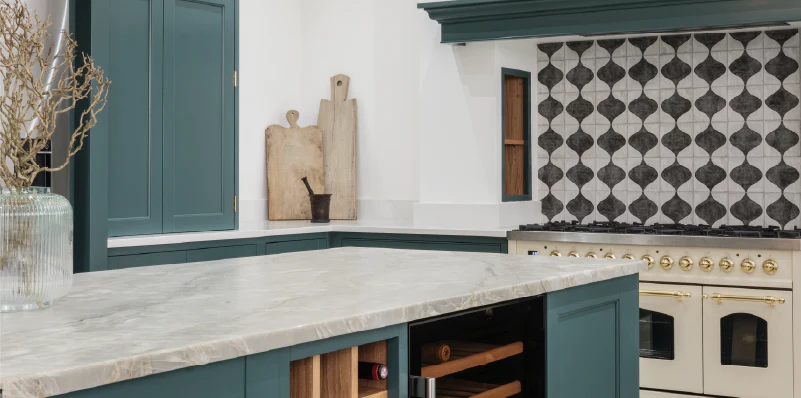
One of the most loved work surface materials of all! As one of the available finishes is similar to marble, you can have a marble-like look but with much more practicality.
Quartz is a man-made composite, which means it’s not natural stone, but instead a mixture of various materials. Made from about 90% natural quartz crystals mixed with a small percentage of binders. It is referred to as both ‘quartz composite’ and ‘engineered stone’, this material is very tough and engineered to create incredibly durable, practical surfaces which are perfect for daily kitchen use.
You can choose from a large range of colours, patterns, and finishes. Some are designed to mimic natural stone like marble or granite, and you can choose between a honed or polished finish as you can with natural stone. As the colour runs through the material, any scratches can be sanded out. In the unlikely event of the composite surface getting scratched, chipped, or stained it can often be repaired by a specialist.
Unlike natural stone surfaces such as marble and granite, the quartz surfaces are non-porous, therefore making them resistant to stains. This makes them the most hygienic countertops available on the market as bacteria or mould cannot build up within the stone. It requires minimum maintenance as there is no need to seal the surfaces.
The quartz surface comes in an extra-large format slab, allowing for greater consistency in design over large spaces such as kitchen worktops. On the downside, the seams on engineered stone countertops are sometimes noticeable, similar to granite countertops, but this isn’t a deal breaker for most people.
Finally, quartz is not as resistant to heat as granite, glass, or concrete. So should be used with caution with hot pots and pans in the kitchen. For a contemporary, upscale look with very low maintenance, quartz countertops are worth considering.
Wooden Kitchen: Hardwood Timber
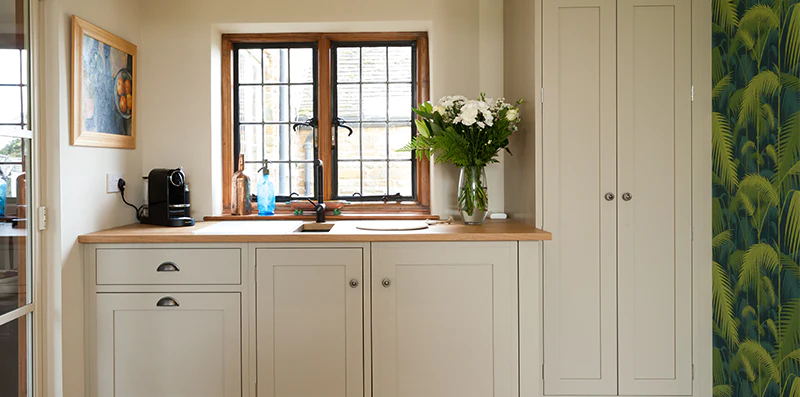
A timberwork surface in a kitchen is a brilliant way to achieve a country look. It can also add an undertone of rustic character in a modern or even industrial-style kitchen.
Oak, maple, beech, cherry, and walnut bring warmth to every sort of kitchen. It’s also a naturally hygienic surface and has antibacterial properties. Hardwoods are the way to go with teak and iroko being great options for around sinks due to their high oil content. This makes them very water resistant.
There is some upkeep involved to make sure your timber looks its best. Spills must be cleaned instantly, and you will need to invest in trivets to avoid scorch marks from hot pans. When first fitted, timber worktops need to be sealed with Danish or linseed oil. Do this every day for the first week, then once a week for the first month, then once a month for the next year to keep it at its best.
Oak work surfaces are higher maintenance. Heavy knocks mean they’re likely to dent, and despite oak being a hardwood, it’ll scratch too. If you spill something on a wooden work surface, there’s more chance of it staining unless you act fast. Even water splashes will leave rings unless wiped away quickly.
On the plus side, burns and scratches can easily be sanded out using fine-grade sandpaper or wire wool. It is also easy to cut, so fitting can be carried out either by your kitchen supplier or by a joiner, in little time and on site too.
Wood is ideal for food preparation and dining areas. For example, in kitchen islands and breakfast bars, It’s much warmer leaning on wood than ice-cold granite!
Marble Kitchen Worktop
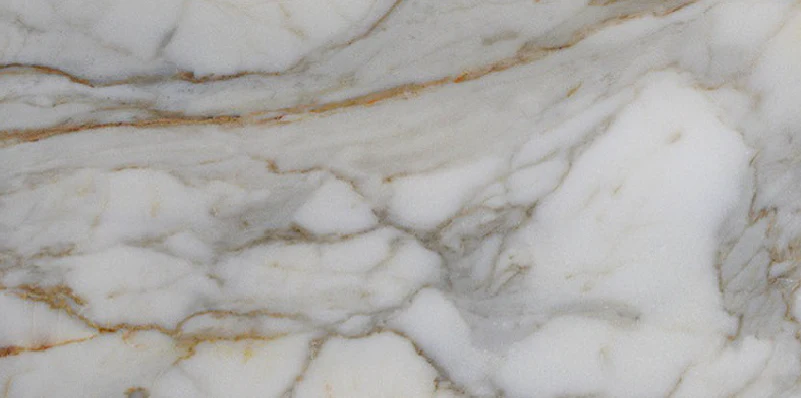
Marble is a natural, metamorphic rock that’s long been loved and remains in heavy demand due to its elegant, good looks. But it does have its flaws!
Most of the marble’s plus-points come down to its good looks – its veining is what gives it most of its character, whether you choose from pale grey lines to dark and dramatic ones, its backdrop colour is both crisp and calm. It also brings plenty of light into your kitchen.
No two slabs are alike, so you’ll be assured of having a unique worktop for your home. It’s very much on-trend, but at the same time, it’s timeless so you know that when a new material takes the limelight, marble isn’t something you’re likely to fall out of love with. Marble has been used in kitchens for hundreds of years and sits wonderfully with our Period kitchens.
Marble is heat resistant. In the kitchen, it stands up well to hot pots and pans. But it’s the porous nature of marble that creates a problem. It’s more porous than granite, so it readily absorbs liquids. That means that oil, wine, juice, and other spills penetrate deeper into the stone very quickly, and they are hard, if not impossible, to get out
Marble can and should be sealed when installed and again every few years. However, if it is not done properly or often enough, staining is a “not if, but when” proposition. Also, sharp knives can scratch the surface and heavy saucepans may chip the marble or even break off a corner.
If you love the look of marble – and it is beautiful! – Consider installing marble worktops in less used areas and mix them with hardwood. Maybe even choose a quartz that is designed to look like marble.
Granite Kitchen Work Surface
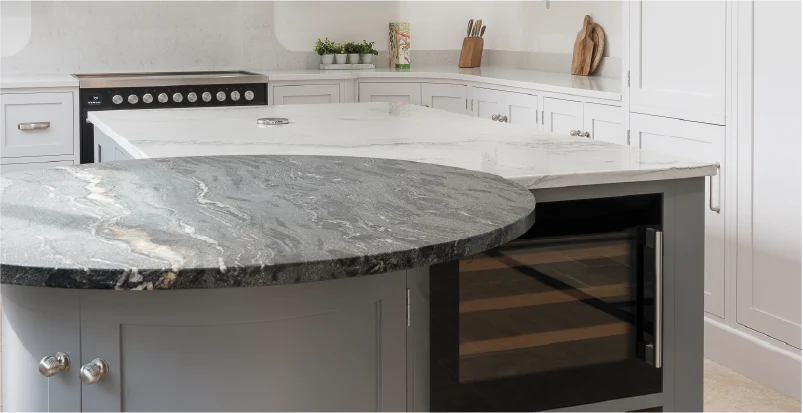
Granite is a natural material, a resilient stonework surface that comes in a wide range of colours. It’s an igneous rock that’s forged in fire, which means that it’s one of the few work surfaces that can manage having a hot pan placed directly on it.
For some, nothing beats the beauty of natural stone, its veining and colouring unique to each slab. It’s a luxury material that never falls out of fashion and suits traditional and modern styles. Choose from a classic polished finish, or a honed matt for a more contemporary look. It’s not as expensive as some other work surfaces because it’s more readily available.
Granite is hard and resistant to heat and scratches, but it must be treated to prevent damage. The best of all-natural materials; it can withstand high temperatures, is water resistant and impervious to most stains. But granite is a porous stone, so wine and citric acids must be cleaned up at once to avoid damaging the stone. It will also need to be protected by a special sealant every year or so.
Granite is a very tough rock, so it’s hard to damage. But the good news is that, if you do, it’s generally very hard to notice and it’s also easy to repair, unlike some work surfaces. The last great thing about granite is that it’s very low maintenance. You can clean it using a damp cloth and a mild detergent.
Glass Kitchen Countertop
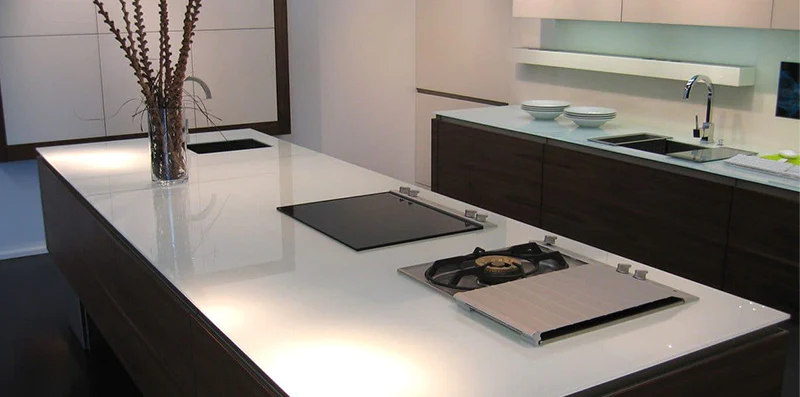
Glass is a recyclable material, which is also one of the main reasons why it has remained so popular. A favourite with interior designers for the light touch it brings to a scheme as well as its reflective sheen that helps boost light levels. Glass countertops come in various styles – back-painted glass, crushed glass, textured glass, or even glass with LED lighting, creating plenty of options
Glass is a non-porous material that can withstand moisture. Spills are easily wiped clean, making it a beautiful – and practical – solution for the kitchen. You can have your worktop shaped and formed to any size, style, texture, and colour. The options are only limited by your imagination. You can even stretch that imagination as glass pairs extremely well with most materials and sits well within contemporary schemes.
Glass for work surfaces is toughened to increase durability. It is heat, acid, and water resistant. Glass can be prone to scratches, but these can be polished smooth. Heavy or sharp objects can cause cracks, dents or chips in glass. You need to avoid these at all costs as unlike other materials, glass is extremely expensive to repair.
Acid and acidic substances, for instance, are harmful to glass. Additionally, if you do not clean your glass countertop properly and regularly, over time water prints make the glass surface appear dull and unappealing. To maintain, you simply use a mixture of soap and water, and the work surface will be back to its shiny appearance. Lastly, since glass is a non-porous material, it should not attract any bacteria or mould.
Acid and acidic substances, for instance, are harmful to glass. Additionally, if you do not clean your glass countertop properly and regularly, water prints will eventually make the glass surface appear dull and unappealing. To maintain you simply use a mixture of soap and water and the work surface will be back to its shiny appearance. Also, since glass is a non-porous material it should not attract any bacteria or mould.
Corian and solid-surface worktops
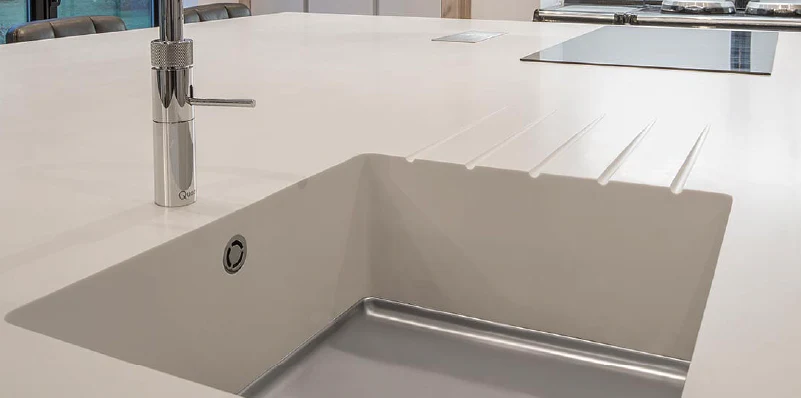
Corian is a particular brand and make-up of solid surfaces, meaning not all solid surfaces are Corian. Made from a blend of acrylic resins, minerals, and colourings, solid surfaces are warm to the touch with a natural lustre. They can be completely seamless too with one-piece, moulded sinks and splashbacks. The composition is consistent all the way through or solid, the same inside and out.
Designs are often pioneering, and the material can be thermoformed into fabulous organic curves, slick cantilevered breakfast bars and seamless wrap-around surfaces on islands. They can be formed into any shape without the need for ugly or unhygienic joints. The material can be engraved, backlit with LEDs and even fitted with built-in wireless charging for smartphones. One of the main advantages of using a Corian worktop is that it is available in a vast array of colours.
It is stain-resistant. This type of material is non-porous, and due to this, the stains caused during kitchen work do not create any permanent damage. Further, it is a non-porous material, it also protects from mould, mildew, and bacterial growth.
Solid surfaces are stain and water-resistant. They’re also heat-resistant to 250°C, but it’s still best to use a trivet. As it is a solid surface material, like hardwood, scratches can be sanded out and damages can be repaired easily. Make sure to dry your worktop, and do not allow it to be wet for a long time. It is important because too much water can cause a film to develop on the surface which will give the countertop a very dull look.
Although cleaning and caring are not difficult, many people do not do it correctly. It is most important for people to understand that one must clean the Corian worktop every day with soapy water or an ammonia-based cleaner.
Stainless-steel worktops
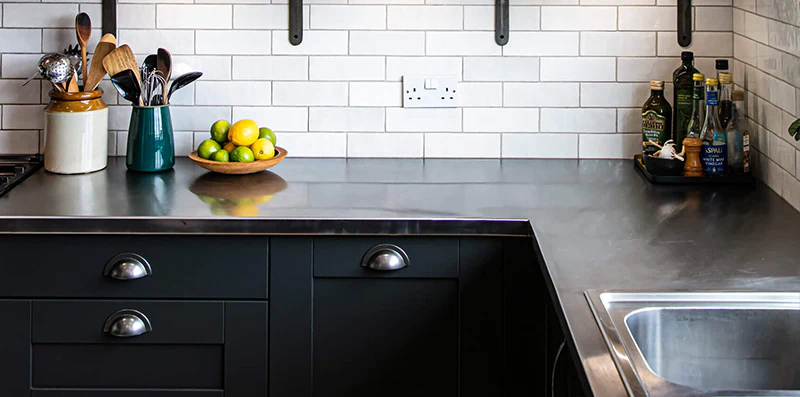
Durable, heat resistant, hygienic and impenetrable to water, stainless steel is an alloy of iron. The presence of chromium makes the steel non-porous and impervious to oxidation and staining. This material is a poor conductor of heat making it resistant to burns from hot pans. Because it is non-porous, it does not hold mould or bacteria, so it is best used around sinks, by the hob and in food preparation areas. A restaurant kitchen favourite and great for creating an industrial look in your home. It works best in contemporary schemes, but you can team it with other materials to soften the look.
Although very strong, waterproof, heat, and acid resistant. It is prone to scratching, but some say this adds to its well-worn appeal, and this won’t affect its anti-bacterial qualities. If you want to prevent or minimise scratching, always use a soft cutting board when using a knife. However, if you do cut directly on the steel, the knife will likely be more damaged than the worktop.
Stainless is often selected because of the carefree nature of the material. Typically, mild soap and water are all that is required to thoroughly clean the surface. If you have a mirror finish, it is advised to use specific stainless cleaners and polishes that help minimise and fill in fine scratches. A brushed finish can hide any scratches that will appear on the stainless surface. If you have a brushed finish, a stainless cleaner will help cut down on the fingerprints that will still be visible on a brushed finish.
Concrete
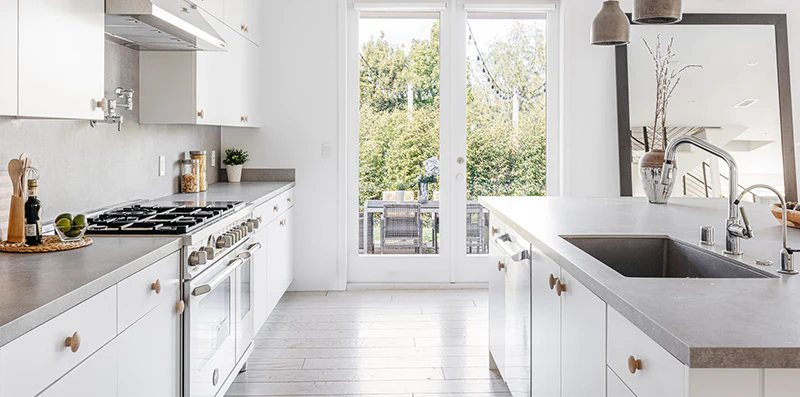
The industrial look of concrete makes it a current choice. It’s also designed to withstand plenty of heavy-duty use and comes in a range of standard concrete mix colours (from white to grey). Concrete can also be mixed with pigments to create stronger colours.
Polished concrete worktops are flat and smooth, but concrete is porous and can absorb liquids and even bacterial growth. It is also very heavy so often extra reinforcements are required.
Concrete worktops will need sealing, but in reality, even sealed concrete like granite and marble will show markings. Especially spills like olive oil, red wine, juice, or coffee. Something as simple as water spots can mark but many love the rustic look and embrace the imperfections as a rich patina that develops over time.
Concrete can crack – it’s a risk that comes along with concrete countertops. Most commonly when poured in place rather than pre-cast. Of course, you can prevent cracks to a certain extent by adding fibre reinforcement, rebar, and/or wire mesh. Still, cracks happen, whether because of pressure or the natural settling of the house. Thankfully, they’re usually not super noticeable and pretty easy to repair.
It takes 28 days for concrete counters to fully cure. It can also be cast into any shape and textured with all kinds of finishes. While it might be a less expensive option than Carrara marble, this work surface isn’t necessarily cheap.
The bottom line? If you’re looking for perfection, you might want to look elsewhere. But if you love the rugged look and are passionate about patina, go ahead and give it a try. Just do your research, and make sure you keep up with the maintenance.
 Bespoke made in 10-12 weeks
Bespoke made in 10-12 weeks  National Installation
National Installation  Worldwide Shipping
Worldwide Shipping 